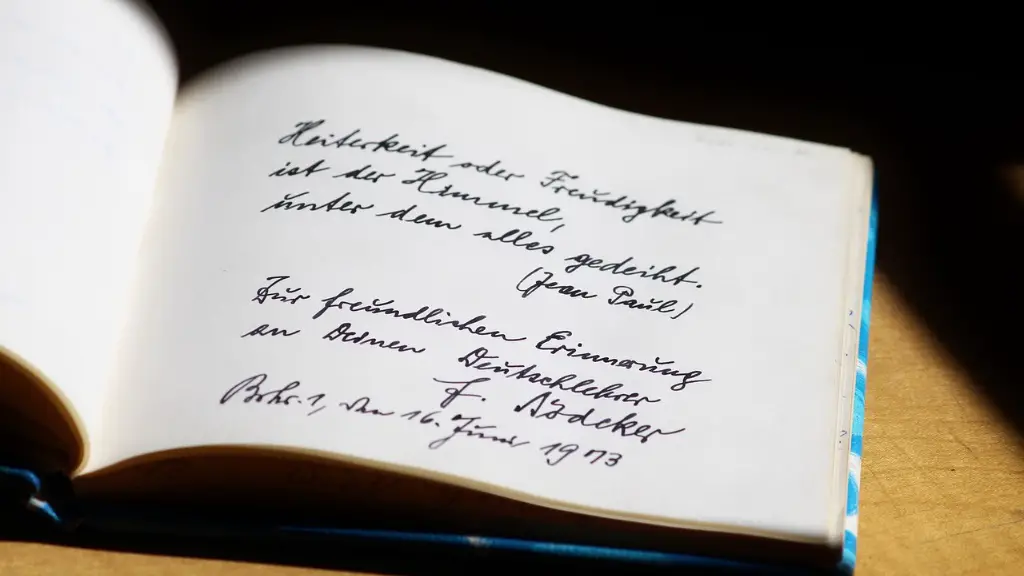What is Sibilance
The term sibilance typically refers to a particular linguistic phenomenon characterized by the use of “s,” “sh,” “z,” and “t” and other soft consonant sounds. It is a highly expressive technique used by poets to emphasize certain words and phrases in their work. Sibilance is the repetition of a sibilant sound at the beginning, middle, or end of a word or phrase for emphasis.
Every language has its own palette of sibilant sounds, but when analysts speak of sibilance in poetry, they usually mean distressingly fricative pronouncements. In this context, what counts as a sibilant sound is relative to a language. For example, in English, the ‘s’, ‘sh’, and ‘t’ sounds all could be considered sibilant, while in Spanish both the ‘s’ and ‘z’ sounds would be considered sibilant.
The art of sibilance dates back centuries, when it was commonly used by poets to capture an object or scene in their words. Often, the goal of a poet is to use words and sounds to evoke an emotional response or spark an intellectual debate, and sibilance often plays a key role in achieving this. Poets find a creative way to weave the sibilance in with the natural flow and rhythm of the poem, giving a heightened intensity and often making it easier to remember and recall the poem.
One example of sibilance in poetry is Robert Frost’s ‘Stopping by Woods on a Snowy Evening’. In this poem, Frost uses repeated ‘wh’ and ‘sh’ sounds to draw the reader’s attention to the snow, thus accentuating the poem’s wintry setting. In addition to the obvious visual images associated with the sibilance, Frost is also highlighting the sound of the winter night itself with the evocative use of sibilant consonants.
Another example of sibilance in poetry is Alexander Pope’s ‘An Essay on Criticism’. The poem includes many words with consecutive ‘s’ sounds, including “self-love” and “suspicion”, that emphasize Pope’s message of overcoming personal prejudice. The use of sibilance in this poem serves to further the sentiment of his message, emphasising the importance of rising above individual opinion for the benefit of society as a whole.
In order to use sibilance effectively, poets need to be able to accurately capture the tone they aim to convey. Sibilance should be used sparingly and judiciously so as to avoid over-compensating or unintentionally highlighting certain phrases. Furthermore, it is recommended that poets familiarize themselves with their chosen language’s phonetics in order to identify where sibilance can be used to add emphasis to a certain phrase or word.
The Power of Sibilance
Sibilance is an important linguistic technique used by poets to convey emotions and communicate meaning. It highlights the significance of certain words, as well as creating a subtle musicality and rhythm to the poem. A well placed sibilant sound can add an extra depth of understanding to the meaning of a poem, and captivate the reader’s attention.
In addition to creating a melody when used with the right sounds, sibilance can also be used to create a sense of atmosphere in a poem. The repetition of sibilant sounds can easily create an atmosphere of suspense, anticipation, or even terror. Many horror films, for example, rely heavily on this phenomenon to scare the audience. Similarly, poetic sibilance can be used to create a feeling of mystery, or even power.
Poets have a wealth of tools at their disposal when it comes to constructing poetry. Amongst these tools is the highly effective technique of sibilance. Not only does it draw the reader into the poem, but it also provides a subtle background of rhythm and atmosphere to the work. Used judiciously and sparingly, the intentional use of sibilant sounds can be a powerful tool for the imaginative poet.
Uses of Sibilance in Poetry
Sibilance can be used by poets for a variety of purposes. Poets often use it for emphasis, especially when a word needs to be highlighted for its importance or to create an emotional reaction in the reader. It can also add to the overall atmosphere of a poem and help the reader to engage with it more deeply.
Another usage of sibilance in poetry is to invoke the imagery of the subject or object being spoken of. This can be used to evoke a certain mood or to emphasize particular syllables in a poem. In addition, sibilant sounds can create a musical cadence throughout a poem, allowing the words to take on a life of their own. This can also draw more attention to certain words or lines of the poem.
Sibilance can also be used to create contrast. By selectively choosing certain words within a poem and emphasizing them with sibilance, a poet can contrast two ideas or concepts to highlight their differences.
Finally, sibilance can also be used to create ambiguity. Poets sometimes deliberately allow their readers to interpret words differently, creating a layer of meaning that can be interpreted in multiple ways. By using sibilance to craft their words, the poet can subtly hint at an alternative interpretation of a poem without needing to state it explicitly.
Context of Sibilance in Poetry
Exploring the context of sibilance in poetry is an important step in understanding the power of this poetic device. In bygone days, sibilance was often used as a form of magical incantation, as in St. Elmo’s Fire—a phenomenon of electrical discharge, where shimmering lights may be seen around high-tension lines. When sibilance is used in contemporary poetry, it often conjures up similar feelings of awe and wonder, of something mysterious and unknowable.
Another context in which sibilance is often used is when a poet wants to slow down the flow of the poem and give the reader a chance to fully absorb what’s being expressed. Sibilance has the effect of taking the reader out of her immediate environment and providing her with an alternate, more unpredictable landscape. This is why sibilance is often used to highlight patterns in a poem, particularly when those patterns are spoken by multiple characters or voices.
But poets don’t just use sibilance to signal atmosphere or to provide contrast between characters. They also use it to create tension and suspense, to draw attention to certain lines or phrases, and to provide a grounding soundtrack of sorts to the poem. When used skillfully, sibilance can be a powerful tool for commentators looking to drive home their point or explore a certain idea in more depth.
The Impact of Sibilance
Sibilance can have a powerful effect on a reader or listener. The slow, rhythmical repetition of sibilant sounds can draw the reader into a feeling of enchantment, or put them in an altered state of awareness. By emphasizing certain syllables, it can even give a poem a magical power, imbuing it with potency and mystery.
As a poet, sibilance allows you to communicate your feelings and ideas, or to establish an atmosphere for the story or poem. When you are aware of the impact of your words and the way they might affect the reader, you have the opportunity to connect to them on a deeper level and create a more lasting interplay. Poetry isn’t just words, it’s an emotion that is shared between the poet and the reader.
Furthermore, sibilance can also evoke a sense of power and authority. Repeating certain sounds can add emphasis to certain words, giving them a commanding presence. This can be an effective tool to establish an atmosphere of authority and respect when delivering a poem or expressing an opinion.
Conclusion
Sibilance is a valuable tool for poets looking to create atmosphere, emphasize words and phrases, or evoke a certain emotion. Used effectively and judiciously, it can be a powerful device for poets to convey their ideas. Essentially, sibilance is an art, and as such it relies heavily on the skill and creativity of the poet to make it work. By understanding the power and potential of sibilance, poets can use it to craft meaningful and powerful poetry.





